WHAT IS A BUYER PERSONA?
DEFINITION OF A BUYER PERSONA
A buyer persona is a semi-fictional representation of your ideal customer based on market research and real data about your existing customers.
When creating your buyer persona(s), consider including customer demographics, behaviour patterns, motivations and goals. The more detailed you are, the better. Buyer personas provide tremendous structure and insight for your company. A detailed buyer persona will help you determine where to focus your time, guide product development and allow for alignment across the organisation. As a result, you will be able to attract the most valuable visitors, leads and customers to your business. Ready to put this definition into practice?
Let's learn how to create a detailed buyer persona for your business.
|
Finance Manager Melanie. Landscaper Larry. Caregiver Cassy. These names refer to personas: fictional, generalised representations of real people. By grouping people into persona categories, it’s much easier for marketers, product designers, salespeople, and services people to tailor their content, messaging, product development and services to different groups of people. |
A Sample Buyer Persona
Marketing Manager Mandy
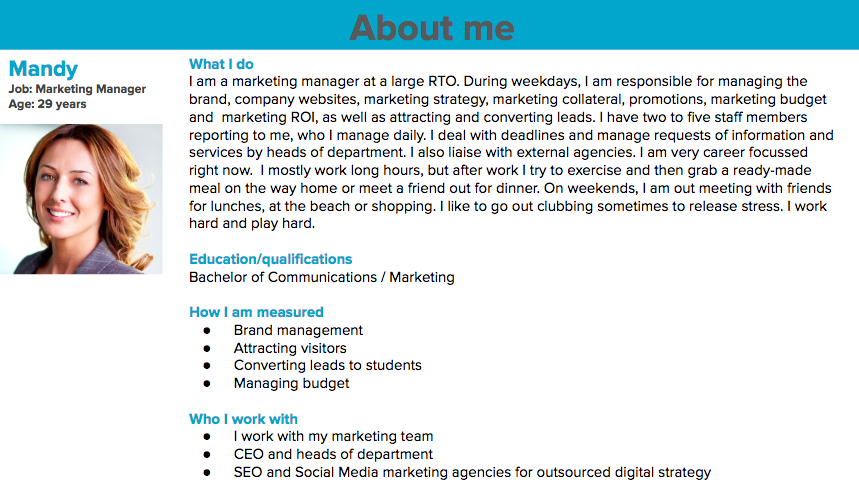
BUYER PERSONA VS BUYER PROFILE
WHAT IS AN IDEAL BUYER PROFILE?
Buyer profiles define the different buying patterns of companies you ideally aim to do business with.
Before you can identify potential buyers, you need to define which buyers you can help and which you can’t. The ideal buyer profile defines which companies are a good fit for your offering and which ones are not. If you are a B2B company, the definition of a buyer profile should be at the company level, not the contact level -- that is, even if your point of contact doesn’t typically make the purchasing decision, they’re still valuable to speak with if their company matches your ideal buyer profile.
Six questions you should ask yourself to identify your ideal buyer profile:
| Q1 | Are there company sizes that are ideal or not ideal who would buy your product? |
| Q2 | Do you define company size as employees, revenue, customers or another metric? |
| Q3 | Are there industries or verticals that are ideal or not ideal? |
| Q4 | Are there geographic locations that are ideal or not ideal? |
| Q5 | Are B2B customers better than B2C? |
| Q6 | Are there other attributes of that make the buyer ideal or not ideal? |
WHY IS A BUYER PERSONA IMPORTANT?
You won’t be able to position what you’re selling to meet customers’ (and potential customers’) needs without knowing who they are. How well do you know your ideal customers’ backgrounds, their goals, and their challenges? How well do you understand their interests and needs? Do you know how old they are? Where they went to school? Whether they have kids? What a day-in-thelife looks like?
These questions may sound specific, but here’s the thing...
Creating very specific buyer personas can dramatically improve your business results.

Without knowing the answers to questions like these, it’s difficult for a business to create an effective strategy to attract, sell to, and delight more of those types of people. In order to grow, you need to understand your ideal customers inside and out and integrate that research across your entire business including various job roles and across the internal business functions.
It is important to know:

What Buyer Persona(s) are, how you can use them, and how to create them. Keep scrolling and you’ll find out how to create buyer personas for your business.
| Buyer personas are an essential component of any inbound marketing campaign. Without them, you’re like Iron Man without his AI assistant - flying blind. |
HOW CAN YOU USE BUYER PERSONAS?
- At the most basic level, personas allow you to personalise or target your marketing for different segments of your audience. For example, instead of sending the same lead nurturing emails to everyone in your database, you can segment by buyer persona and tailor your messaging according to what you know about those different personas.
- If you take the time to create negative personas, you’ll have the added advantage of being able to segment out those that you specifically do not want to target (the “bad apples”) from the rest of your contacts. This can help you achieve a lower cost-per-lead and cost-per-customer (and see higher sales productivity) because this highly focused approach will only attract precisely the right target persona(s).
- When combined with lifecycle stage (i.e. how far along or where someone is, in your sales cycle), buyer personas also allow you to map out and create highly targeted content and identify conversion points.
Buyers are 48% more likely to consider a solution that personalise their marketing to address their specific business issues
ITSMA
HOW DO YOU CREATE BUYER PERSONAS?
Buyer personas are created through research, surveys, and interviews of your target audience. That includes a mix of customers, prospects, and those outside of your contact database who might align with your target audience.
Here are some practical methods for gathering the information you need to develop personas:
INTERVIEW CUSTOMERS
Interview customers -- and potential customers -- either in person or over the phone, to discover what they like about your product or service. Ask questions about their job role and title, what a typical day-in-the-life looks like (both at work and outside of work), what tools they use in their job, what their challenges are, how they learn new information or acquire new skills, where they’re from, how they search for information on the internet, and so on. Here’s a list of 20 questions to ask during a persona interview to help guide you.
LOOK FOR BEHAVIOURAL TENDS
Look through your contacts database to uncover trends about how certain leads or customers find and consume your content.
OPTIMISE FORMS FOR YOUR PERSONA.
When creating forms to use on your website, use form fields that capture important persona information. For example, if all of your personas vary based on company size, ask each lead for information about company size on your forms.
TALK TO YOUR SALES TEAM
Consider your sales team’s feedback on the leads they are interacting with most. What types of sales cycles does your sales team work with? What generalisations can they make about the different types of customers you serve best?
|
Bonus Tip: Start with one, core persona and build up from there Your content strategy should align with your ideal buyer persona(s). To ensure the exercise and approach is not too daunting, start with the persona that results or will result the most critical mass, respective to sales and contact engagement. Remember: the reason you’re creating personas is so you can create an experience that resonates with each of them. This will lead you to having a far clearer picture of the persona your marketing should be targeting. There should be clear differentiators between each one of your personas. |
PERSONA EXAMPLE
Here’s an example of a persona we created using the HubSpot buyer persona template which you can download (here). We’ll call her Sample Sally.
- SECTION 1: THE “WHO?”
In the first section, you’ll fill out your persona’s background, demographics, and identifiers (like demeanor and communication preferences).
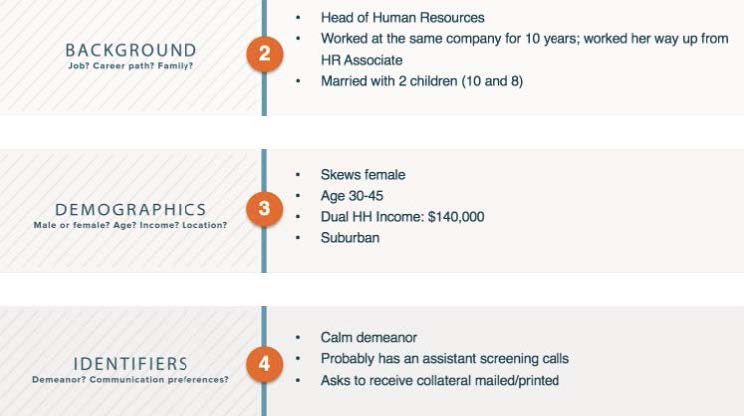
| Tip: to help when planning and building the 'who' of your buyer persona(s), think of this exercise like the process one would go through when choosing a gift for someone; it helps to think of as much about the individual as possible, relating to their background, personality and content. This is similar to our buyer persona(s) discovery process for background, demographics and identifiers. |
- SECTION 2: THE “WHAT”
Next, you’ll fill in your persona’s goals and challenges, followed by what your business can do to help them achieve their goals and overcome their challenges.
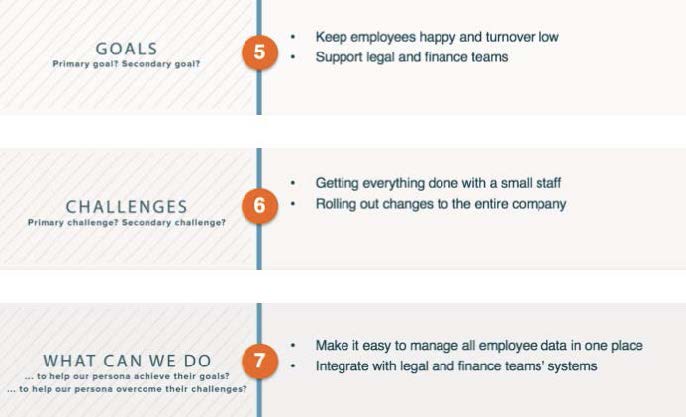
- SECTION 3: THE “WHY”
Here’s where you can input real quotes from customers and potential customers from the surveys and interviews you conducted for persona research. You can also input common objections -- reasons your ideal buyers have said they wouldn’t want to buy your offering.
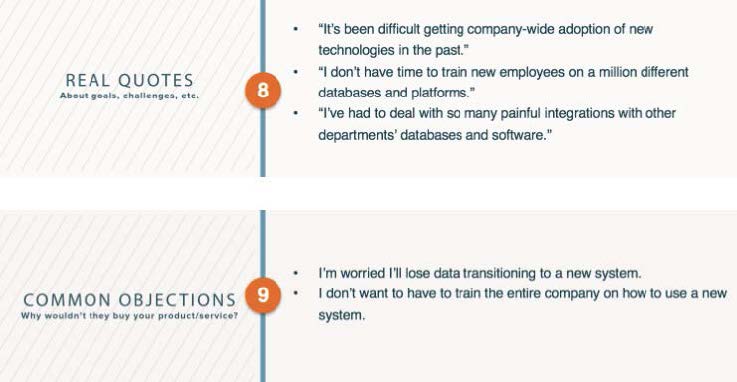
A MarketingSherpa case study found that buyer personas added the following value:
a 900% increase in length of visit,
a 171% increase in marketing-generated revenue,
a 111% increase in email open rate,
and a 100% increase in the number of pages visited.
Act-On
- SECTION 4: THE “HOW”
Finally, you can fill in the marketing messaging you want to use for this particular target buyer. How should you describe your offering to this persona? What’s your elevator pitch to them?
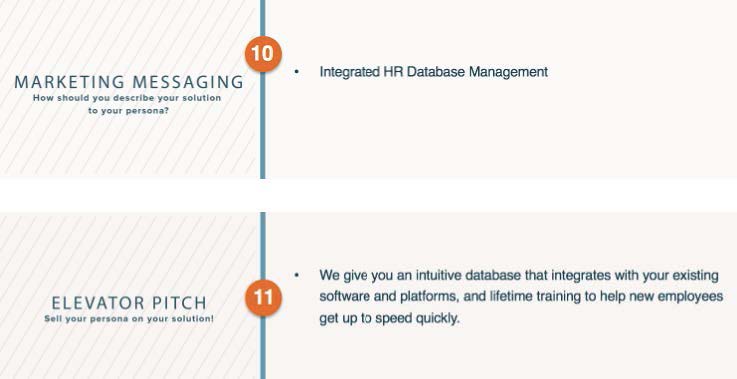
|
Tip: once you've created formal buyer persona(s), review and update (if necessary) your Brand Identity Guidelines and related assets (including Tone of Voice), since these may require adjustment and update, better suited and aligned to your newly defined buyer persona(s). |
Use this example as a guide to customise your own buyer personas, and use them to organise your audience segments and strengthen your marketing.





.png?width=384&name=Lupo%20Digital%20logo(white).png)